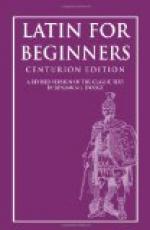s\ is like s in sea, never
as in ease ro’-sa, is
t\ is always like _t_ in
_native_, never as in _nation_ ra’-ti-o:, na:’-ti-o:
v\ is like w in wine, never
as in vine vi:’-num, vir
x\ has the value of two
consonants (_cs_ or _gs_) and
is like _x_ in _extract_, not
as in _exact_ ex’-tra:, ex-a:c’-tus
bs\ is like ps and bt\ like
_pt_ urbs, ob-ti’-ne-o:
ch\, ph\, and th\ are like
c, p, t pul’-cher, Phoe’-be:,
the-a:’-trum
a. In combinations of consonants give each its distinct sound. Doubled consonants should be pronounced with a slight pause between the two sounds. Thus pronounce tt as in rat-trap, not as in rattle; pp as in hop-pole, not as in upper. Examples, mit’-to:\, Ap’pi-us\, bel’-lum\.
SYLLABLES
_8._ A Latin word has as many syllables as it has vowels and diphthongs. Thus aes-ta:’-te\ has three syllables, au-di-en’-dus\ has four.
a. Two vowels with
a consonant between them never make one
syllable, as is so often the
case in English. Compare English
inside with Latin i:n-si:’-de.
9. Words are divided into syllables as follows:
1. A single consonant between two vowels goes with the second. Thus a-ma:’-bi-lis\, me-mo’-ri-a\, in-te’-re-a:\, a’-best\, pe-re:’-git\.[3]
[Footnote 3: In writing
and printing it is customary to divide
the parts of a compound, as
inter-ea:\, ab-est\, sub-a:ctus\,
per-e:git\, contrary to
the correct phonetic rule.]
2. Combinations of two or more consonants:
a. A consonant followed
by l or r goes with the l or r.
Thus pu:’-bli-cus\,
a’-gri:\.
EXCEPTION. Prepositional compounds of this nature, as also ll and rr, follow rule b. Thus ab’-lu-o:\, ab-rum’-po:\, il’-le\, fer’-rum\.
b. In all other combinations
of consonants the first consonant
goes with the preceding vowel.[4]
Thus mag’-nus\, e-ges’-ta:s\,
vic-to:’-ri-a\, hos’-pes\,
an’-nus\, su-ba:c’-tus\.
[Footnote 4: The combination
nct is divided nc-t, as fu:nc-tus,
sa:nc-tus.]
3. The last syllable of a word is called the ul’-ti-ma; the one next to the last, the pe-nult’; the one before the penult, the an’-te-pe-nult’.
10. EXERCISE
Divide the words in the following passage into syllables and pronounce them, placing the accent as indicated:




